Userpilot has established itself as one of the leading options that SaaS companies can turn to in order to enhance user onboarding, feature adoption, and engagement. It enables teams to build custom in-app experiences without any line of code. Offering such features as A/B testing, NPS surveys, user segmentation, and behavior-triggered workflows, Userpilot allows product teams to guide users through their journey and learn how they are interacting with the platform.
Its no-code solution, along with integrations such as HubSpot, Amplitude, Segment, and Mixpanel, assists product-led teams in making the right decisions and keeps churn down. However, with the growing demand for more flexible or cost-effective platforms, many businesses are now actively exploring Userpilot alternatives to find tools that better fit their specific needs and budgets.
As powerful as Userpilot is, it might not be the best solution out there. Not everybody will need the advanced features hidden behind the more expensive plans, and the onboarding experience of a new user can be intimidating. Be it that you need a more affordable alternative, extra offline functionality, or a tool that has other customization options, it is worth checking out other alternatives.
This blog will guide you through some of the most promising alternatives to Userpilot that will assist you in making your product meaningful, simplifying onboarding, and enabling your users to receive the best alternatives to Userpilot.
What to Consider in a Userpilot Alternative
When selecting a Userpilot alternative, it is necessary to make sure that a new tool fits your product and team possibilities and intentions. The eight essential features to consider are as follows:
- No-Code Onboarding Builder: Seek out tools that enable non-developers to build onboarding flows, modals, and tooltips without understanding code.
- Targeting and Segmentation of Users: Behavior, lifecycle stage, or demographic segmentation of users is a factor that contributes to the delivery of personalized experiences.
- In-App Guidance and Tooltips: A successful onboarding process may need contextual suggestions, make sure the alternative permits tooltips, list items, and guided tours.
- Analytics A/B Testing: In-line testing and reporting assist in measuring the effectiveness of onboarding components and make them bolstered progressively.
- Multi-Language Support: When you have a worldwide audience, make sure that the platform can be scaled to a multilingual experience with ease.
- Third-Party Integrations: They can be enriched with compatibility with analytics and CRM tools such as Mixpanel, Segment, and HubSpot to provide more information about your users.
- NPS and Feedback gathering: This can be achieved through tools that have in-built Net Promoter Score surveys or any other forms of feedback to give direct user sentiment.
- Elasticity and Costs: Select a platform that you can afford at the moment, which can, however, expand with your number of users and your feature requirements.
List of Top 10 Userpilot Alternatives
1. Whatfix
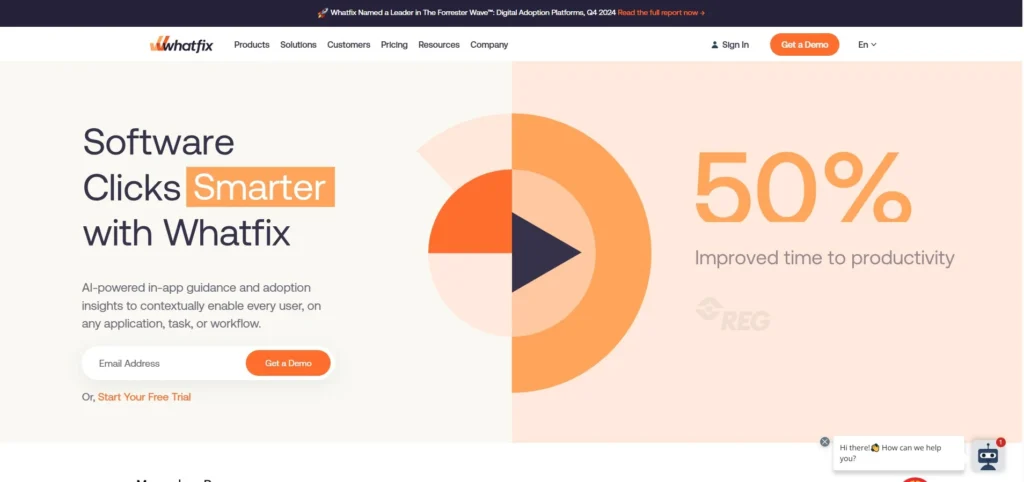
With Whatfix, businesses ensure that users are more engaged and work better on desktops, on the web, and through apps on mobile devices. Using the app, it is possible to append simple-to-use features such as in-depth walkthroughs, useful pop-ups, task lists, and tooltips without a single line of code.
You can use the analytics tool to determine how individuals are utilizing the platform and identify the areas where you need to provide additional training. It matters to the enterprise leaders because digital transformation will reduce expenditure on support, allow workers to adapt to new software, and increase their returns.
As one of the most recognized Userpilot alternatives, the company has been identified as scalable, secure, and able to work reliably with Salesforce, Workday, and Microsoft Dynamics by some of the largest corporate ventures in the world. If you’re exploring other options, here are some excellent Whatfix Alternatives to consider.
Key Features:
- No-code that allows its users to direct and walk their customers through the app.
- The content will offer videos and tooltips in addition to other lessons.
- Compatible with Salesforce, Workday, and Microsoft Dynamics.
- Helps in the initialization, setup, and acclimatization of people to the system.
- The ability to access the app using other devices.
Pros:
- Handy information to look at the numbers that are utilizing your service.
- Your service can be utilized by global teams in numerous languages.
Cons:
- The operation of a small business might be high owing to high prices.
- It is time-consuming to start establishing your system.
2. Chameleon
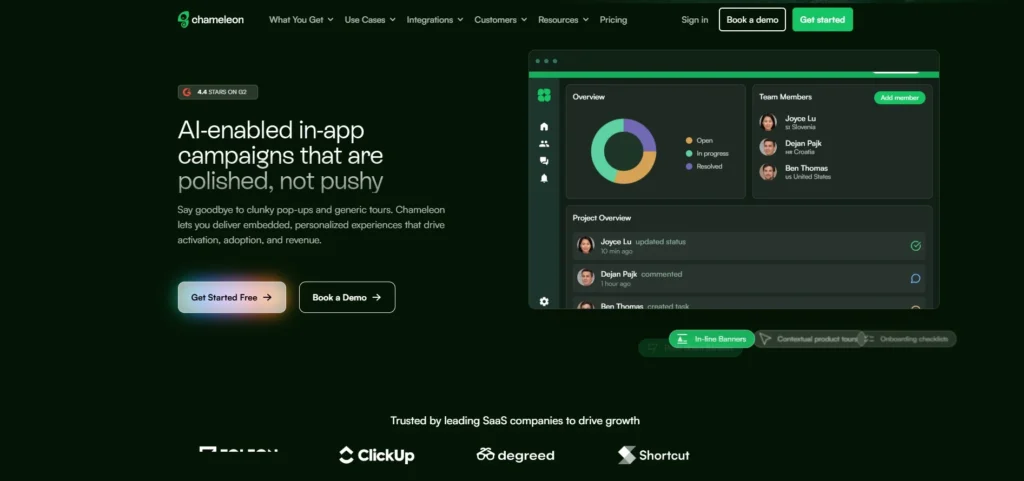
Chameleon, one of the emerging AI data analytics tools, allows SaaS businesses to provide users with a clear explanation of the new features depending on the interests of a specific user. Product Tours, Slide-Outs, Tooltips, and in-app messages are useful when you need to assist users of any kind.
With Chameleon, teams can go ahead and launch onboarding directly without involving any developers, and advanced targeting means the right information will be displayed to the right users. Combining it with Segment, Amplitude, Intercom, and HubSpot will enable data-working teams to do more.
On Chameleon, users get to take short micro-surveys that enable companies to measure their satisfaction and determine what they think. By embracing Chameleon, product-led teams are making it simpler to onboard users, ensure repeat visits, and improve the user experience, all of which can be tracked.
Key Features:
- There is a visual builder of tours, tooltips, and modals.
- Powerful Customer targeting capabilities by various criteria.
- Deploying micro-surveys to get feedback.
- Integrates with Segment, Amplitude, and Intercom.
Pros:
- One can also design the interface in whatever way desired.
- It is suitable to be used by product-led growth teams.
- Allows users to express their minds at all times.
- The plugin is easy to use and does not need a developer.
Cons:
- There are areas in the workshop that you need to code.
- Not many non-Internet users.
3. Usetiful
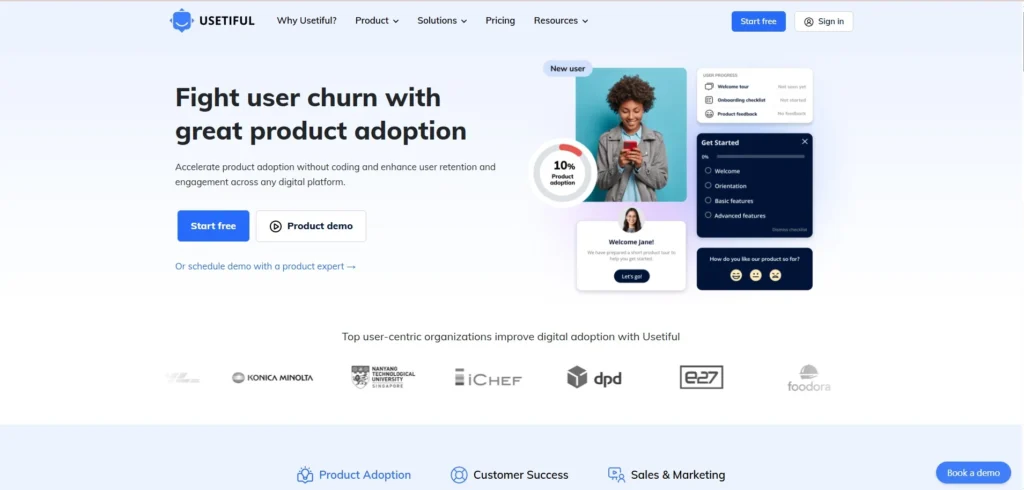
Usetiful can be used by everybody, irrespective of their technical understanding, to create user flows with ease. Since Usetiful offers multilingual support, targeted actions, and integrates seamlessly with Google Analytics and Segment, teams across the globe can utilize it without any problems.
By understanding customer behavior, teams can enhance how their app is used, driving better engagement and user satisfaction. Online shop platforms, SaaS companies, and in-house software teams can all benefit from implementing tools like Usetiful. As one of the top Userpilot alternatives, Usetiful stands out for its simplicity and global accessibility.
Key Features:
- And assisting CMOs to get the right customers with the right words.
- Google Analytics and Segment are integrable.
- Dashboard analytics that offer user engagement information.
- XML sitemaps support official sites and web, and SaaS products.
Pros:
- The price is low, and SMBs discover that the price is right.
- The techniques that allow targeting and segmenting with ease.
- Support for multilingualism is offered.
Cons:
- Does not embrace advanced analytics.
- Limited methods of altering the appearance of the phone.
- It does not favor massive business entities.
4. Intro.js
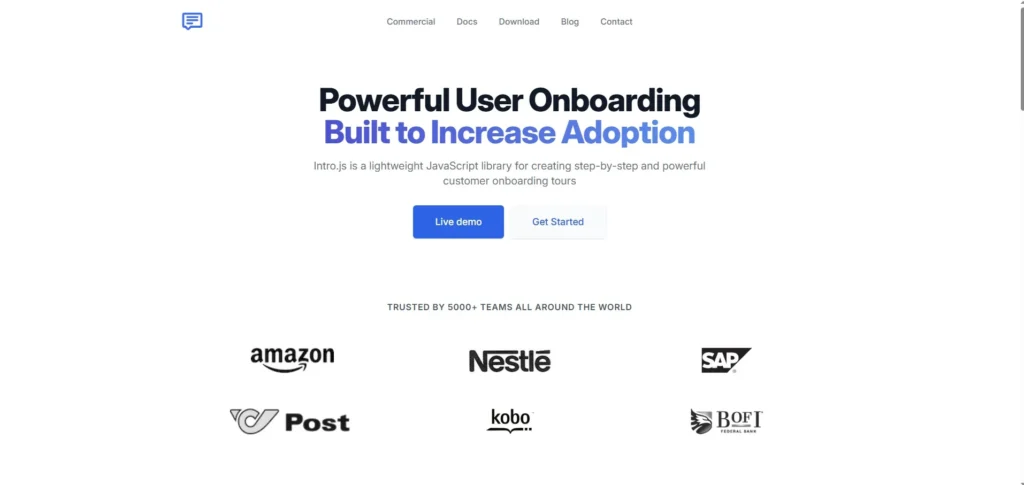
Intro.js is a JavaScript library that is free of cost that assists web developers in describing individual steps of a process to users utilizing a website. To individuals or teams developing software, No-Depends makes it simple to introduce new features. Intro.js assists you in configuring tours and demonstrating new UI components without difficulties, whether it is a prototype or a live application.
It is not as good as WalkMe or Whatfix, but handy in case of skilled companies, which want to develop the walkthrough on their own. The possibility to modify React and adapt it to diverse requirements creates demand among new startups and individual developers.
The community around Intro.js is very helpful and has useful guidance. In case you are interested in a self-hosted solution to using GIS that is both easy and will not cost you a fortune, you can rely on Intro.js.
Key Features:
- A lightweight open-source JavaScript library.
- There is no additional need, and the template is simple to modify.
Pros:
- It is awesome for small firms and organizations.
Cons:
- It has no internal analytics or list segmentation options.
- The process has to involve developers.
- Missing all the additional features that paid tools have.
5. Toonimo
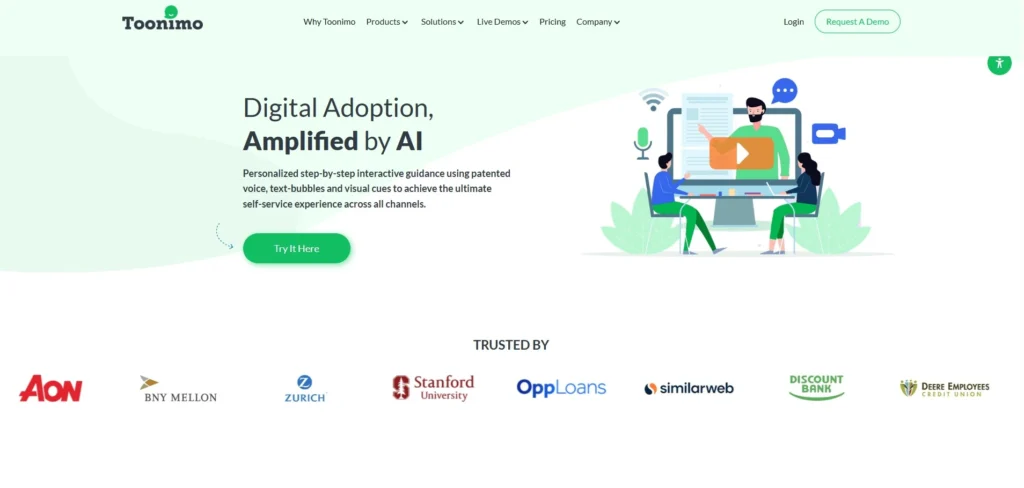
Toonimo uses animated sketch images combined with voice-over explanations to guide users through each step of a setup process. These interactive elements make websites and web apps significantly more user-friendly, especially in industries like banking, insurance, and enterprise software, where users need instant clarity on what’s happening.
With Toonimo, companies can tailor audio and visual tutorials to suit different user segments. It integrates with popular CRM and analytics tools, enabling organizations to better understand user behavior and deliver customized training. As one of the more innovative Userpilot alternatives, Toonimo offers a simple yet powerful way to onboard and train users effectively, making it especially valuable for companies aiming to streamline complex processes.
Key Features:
- Site-guided tour videos.
- You may create animations and scripts as you want.
- The use of both CRM and analytical tools would be adopted.
- Supports large organisations in operating complicated software packages.
Pros:
- Instead of text-driven content, voice-driven content guides consumers.
- Inductions that require being taken through steps would be perfect.
- Provides straightforward guidelines to reduce users’ queries.
Cons:
- There are very few services provided offline.
6. Pendo
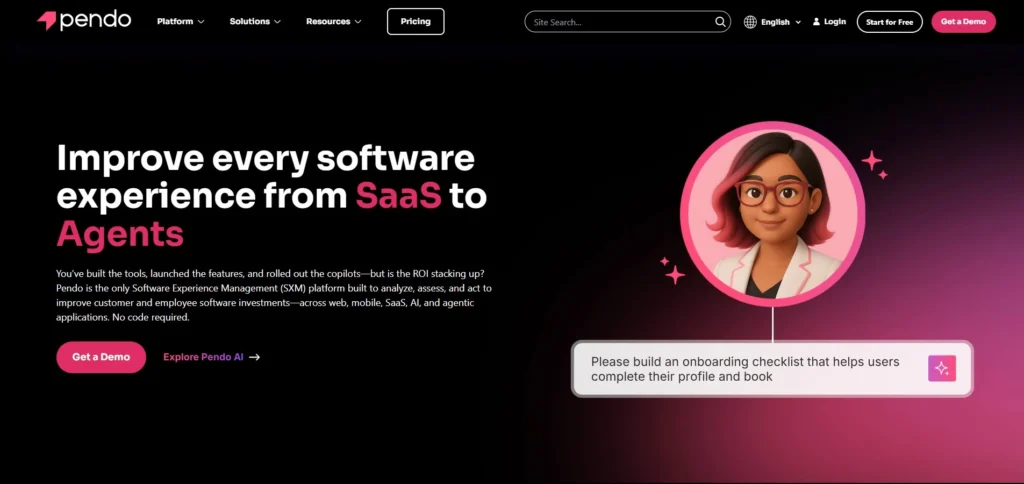
It is a mixture of user journey analysis and overcoming obstacles, and navigating within the app itself, which enables the customers to become familiar with the product quicker. User behaviors are simple to study because no modification of the product code is required.
Pendo offers walkthroughs, tooltips, polls, and NPS surveys to help organizations onboard users and gather valuable feedback. Its tools allow for a personalized user experience across various applications. While it’s a popular choice, many businesses also explore Pendo alternatives to find a platform that best suits their specific needs and budget.
Many product managers attempt to correlate user data with insights about how people behave with the product and onboard in the real world.
Key Features:
- You can run analytics on your products with a no-code installation.
- Create surveys, incorporate tutorials, and gather user feedback within the app.
- Isolating users to provide them with personalised experiences.
- The advantage of using both CRM and a marketing tool.
- Both web and mobile-working software.
- Real-time data that depicts the behavior of an organization.
Pros:
- utilizes not only analytical data but also data interaction tools with customers.
- Decent tools to segment and focus on customers.
- Ideal Goal for Teams using Product-Led Growth strategy.
- Our instruments facilitate the request to give sincere feedback and comments from customers.
Cons:
- Starting up is expensive.
7. Appcues
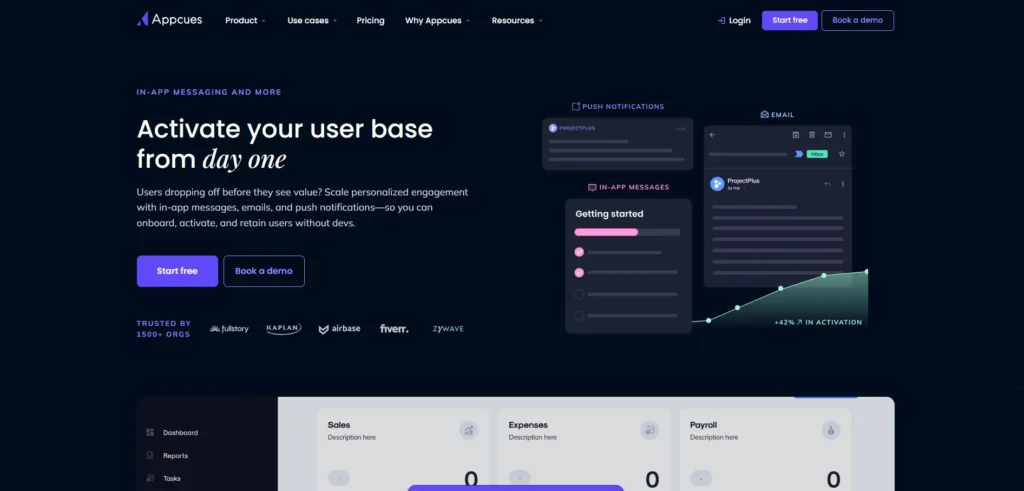
Appcues ensures that every user receives the right message at the right time through intelligent segmentation. Its user-friendly CMS allows marketers and product teams to easily make edits without needing developer support. With built-in analytics, teams can assess whether their onboarding flows and feature walkthroughs are effectively supporting user needs.
Teams can now build custom in-app experiences that welcome users, demonstrate how features work, offer helpful tips, and guide them through key actions.
As one of the leading Userpilot alternatives, Appcues helps SaaS companies reduce churn, encourage faster adoption of new features, and support growth by enhancing the overall user experience.
Key Features:
- Segmentation of the user base.
- A/B testing during the onboarding.
- Integrates with Mixpanel, Segment, and HubSpot.
- Information about individual interaction with information.
- Com Works on browsers and devices.
Pros:
- Giving each user his or her own customized experience is easy.
- The visual editor can be used by marketers.
- Quick releases that do not require the intervention of a developer.
Cons:
- The operation of cloud applications can easily turn out to be expensive.
- organizations that have hundreds or thousands of individuals utilizing them.
- Lower-end analytics compared to what rival platforms have to offer.
- There are several UI elements that cannot be modified easily.
8. Apty
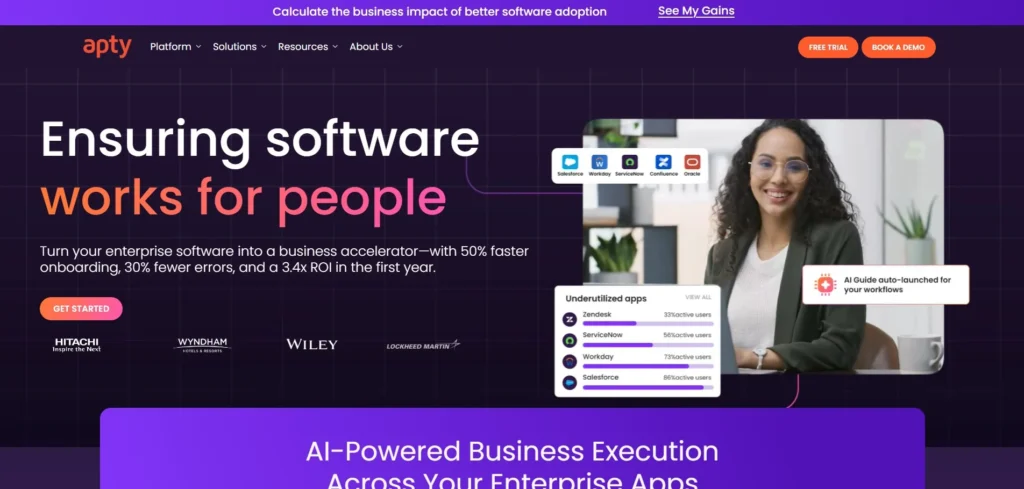
Apty, we use a Digital Adoption Platform to assist enterprises in utilizing their software tools to their full extent. Adoption Pathway presents steps on the screen, makes procedures foolproof, and supplies data to companies so that they can swiftly deal with any problems their employees might encounter.
Large-scale digital changes frequently turn to Apty due to its enhanced features of change management. Any person, without summoning a technician, can create tutorials, walkthroughs, and tooltips using the no-code editor. The Apty tool shows the user how to complete their jobs correctly.
When the system can integrate with CRM, ERP, and HCM solutions, this enables greater versatility of the system. With apty, organisations stretch their adoption and familiarity with new software because of the good customer care, the easily available customisation, and because of the business approach which is expressed in terms of goal achievement.
Key Features:
- Individuals can also follow no-code walkthroughs and remain adherent to established procedures.
- Live notifications and numbers that show the way the product is going viral.
- Listening to change management and productivity.
- Segmenting users and then targeting them according to the segmentation.
- Supports varied languages and platforms.
Pros:
- Be attentive to compliance and be productive.
- Excellent software to support change management.
- It is simple to create content without writing code.
- Information that can be useful in making a better decision.
Cons:
- These payouts aim at institutions that have funds to spare on the likes of services.
- In the case of small teams, the learning process tends to be steeper.
- The platform handles third-party applications relatively less as compared to other brands.
9. Heap
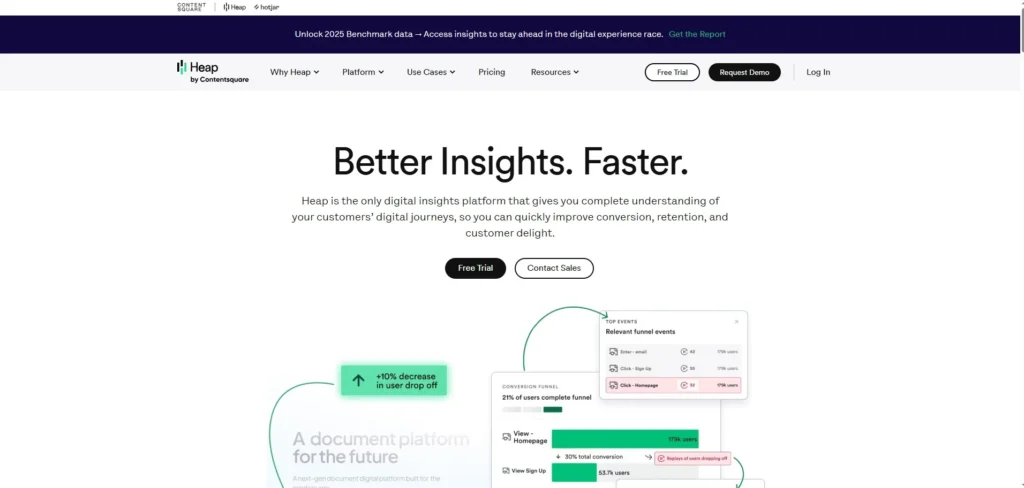
Heap is a powerful product analytics platform that enables teams to gain insights into user behavior without the need to manually track events. It offers advanced visualizations, funnel reports, and user journey tracking to pinpoint where users drop off or encounter friction. While it’s not a direct onboarding tool, Heap plays a crucial role in optimizing onboarding strategies by revealing real-time usage patterns and problem areas.
As one of the most data-driven Userpilot alternatives, Heap is particularly valuable for product teams, marketers, and UX designers who want to base decisions on granular behavioral insights rather than assumptions. With scalable analytics and seamless integration capabilities, Heap serves as an ideal backend for any onboarding strategy, especially when paired with in-app experience platforms.
Key Features:
- Record User actions automatically.
- Funnel analysis, journey analysis.
- Behaviour tracking in real time.
- Ex post event tracking.
- Cohort report and retention report.
- Seamless connections (HubSpot, Segment, and so on).
Pros:
- Automatic anonymous tagging.
- Retroactive analytics is highly flexible.
- Drilled down visual funnels and reports.
- Improves the onboarding with behavioral insight.
- pliers with increasing data requirements.
Cons:
- Does not have onboarding flow creation in-built.
- It may intimidate non-technical users.
- High features might need training.
- Expensive for small startups.
- Information over-without filters.
10. Tutorial
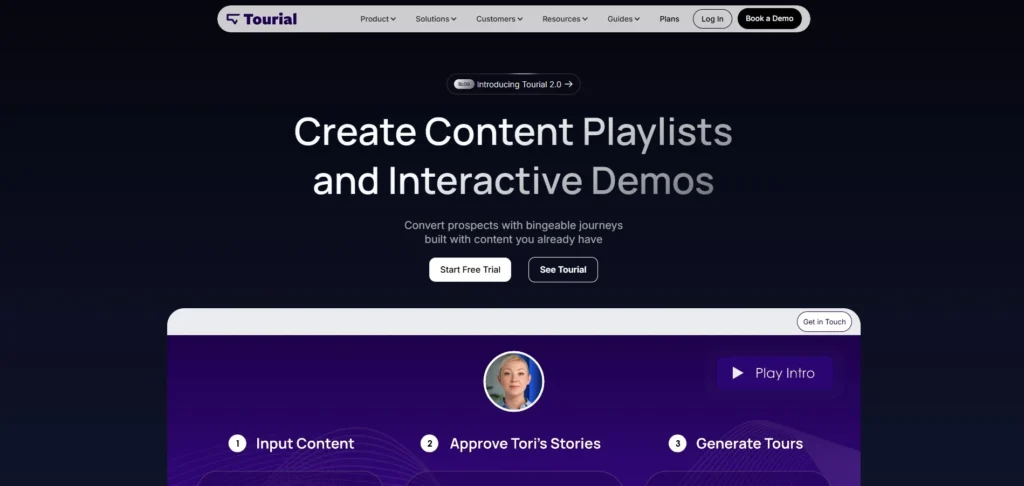
Tourial is a product designed specifically for marketing, which allows businesses to build engaging, self-guided product tours and demos. These tours can be embedded on any websites, emails, and landing pages so that even before signing up, potential users can get a feel of the product. Tourial will fill the gap between marketing and product interaction by demonstrating the worth of your software immediately.
It is perfect for the marketing and demand generation teams that aim to promote lead conversion and decrease the buying journey friction. Transparency and trust are enhanced, as users are able to discover features at their own time. It provides easy analytics to understand the user engagement on each tour to narrow down the messaging and design. Although it is not an in-app onboarding tool, Tourial is a powerful pre-onboarding tool that can be used together with onboarding tools such as Userpilot to manage user expectations early.
Key Features:
- Interactive product tours, which can be embedded.
- Tour-builder no-code editor.
- Tracking and conversion leads information.
- CRMs and marketing tools integration.
- Engagement analytics dashboard.
- It is compatible with several devices.
Pros:
- Excellent pre-sign-up activity.
- Tours can be created without a single line of code.
- Conversion boost by way of interactive demos.
- Integration of CRM and marketing tools without any problems.
- simple to insert within channels.
Cons:
- In-app onboarding is not an option.
- Poor interactivity (not including demos).
- It may be too costly for smaller companies.
- Needs a content strategy that is marketing-oriented.
Conclusion
Userpilot is a strong player in the user onboarding and product experience space, but it’s far from the only option. Depending on your company’s size, budget, technical needs, and onboarding goals, there are many Userpilot alternatives that may be a better fit. Tools like Appcues and Chameleon offer rich, customizable onboarding flows, while analytics-centric platforms like Heap help optimize the user journey using deep behavioral insights. Other solutions, such as Tourial, focus on engaging and converting users even before they sign up.
Whether you’re seeking greater customization, better pricing, or deeper integrations, the right alternative can help you build a seamless onboarding experience that drives user engagement and boosts product adoption. Take the time to compare each platform’s features against your specific requirements, because the best onboarding tool is the one that empowers your users to succeed long term.
FAQs
1. What is Userpilot primarily used to do?
Userpilot is a no-code in-app onboarding tool that is used to increase product adoption.
2. Does Userpilot have a free alternative?
Yes, Intro.js is a light, open-source option that can be used in simple onboarding.
3. What is the best Userpilot alternative (analytics)?
Heap is best suited to profound behavioral analysis and user funneling.
4. Is it possible to use Tourial to onboard inside an app?
Tourial is most suitable in pre-signup demos, but not post-login onboarding in the app.
5. What is the closest alternative to Userpilot?
One of the most similar alternatives in features and application cases is Appcues.



